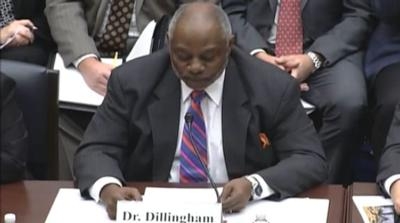Testimony In Hearing On Integration Into The NAS
While there has been a great deal of talk about a proposed rule for integrating UAVs into the National Airspace System coming before the end of the year, the Government Accountability Office says a final rule is still a long way off.

During testimony before the Aviation Subcommittee of the House Transportation Committee, Dr. Gerald Dillingham, Director of Civil Aviation Issues, Government Accountability Office, said actual integration is still years in the future. "A critical step for allowing commercial operations is the publication of a final rule," Dillingham said during his opening remarks. "To develop the rule, the FAA must publish a Notice of Proposed Rulemaking. However, as you've heard, the NPRM has been significantly delayed. Given the time that is generally required for rulemaking, and the tens of thousands of comments expected on this NPRM, the consensus of opinion is that the integration of unmanned systems will likely slip from the mandated deadline of September 2015 until 2017 or even later."
"We agree this is taking too long," said Peggy Gilligan, the FAA's Associate Administrator for Aviation Safety. Gilligan said that the FAA is trying to streamline the process for exemptions to enable broader use of civil UAS in the NAS, citing the example of five exemptions granted by the agency Tuesday.
Capt. Lee Moak, president of ALPA, said that ALPA supports the safe use of unmanned aircraft systems. “We recognize the potential benefit to our nation’s economic competitiveness, but we also recognize the potential for a safety risk if we don’t treat them as what they are––airplanes in the airspace,” Moak said
As head of the world’s largest non-governmental aviation safety organization, ALPA’s president cautioned against allowing pressure to rapidly integrate UAS into the national airspace to rush a process that must be solely focused on safety. UAS and remotely piloted aircraft systems (RPA) include aircraft ranging in size from as small as a bird to as large as an airliner.

Capt. Moak said that standards and technologies must be in place to ensure the same high level of safety as is currently present in the National Airspace System (NAS) before a UAS/RPA can be authorized to occupy the same airspace as airlines or operate in areas where it might inadvertently stray into airspace used by commercial flights.
“We also need to make certain the UAS pilots are properly trained and understand the consequences of possible malfunctions,” said Capt. Moak. “A pilot in the cockpit of an aircraft can see, feel, smell, and hear indications of a problem and begin to formulate a course of action long before even the most sophisticated indicators verify the trouble. Without a pilot on board, we lose this advantage.”
ALPA has long maintained that, without a pilot on board, it is essential that UAS pilots are highly trained, qualified, and monitored to meet the equivalent standards of pilots who operate manned aircraft.
ALPA’s president also underscored that the FAA’s resources are limited, and the agency must have a long-term, sustained source of funding, as well as realistic timelines and a systematic approach that builds the path of UAS integration based on safety.
”We look forward to working with Congress to ensure that safety is held paramount in bringing UAS into the national airspace,” concluded Capt. Moak.

Subcommittee chair Rep. Frank LoBiondo (R-NJ) (pictured) said there are many issues surrounding UAS the committee and the FAA need to consider. "The first and foremost is safety. Our nation’s safety record is the result of decades of hard work by thousands, and also some hard lessons learned. Safety is the cornerstone of the U.S. aviation industry, and without it, the UAS industry cannot succeed, period. Thus, I get very concerned when I read in the Washington Post that the FAA is receiving about 25 reports each month from pilots about UAS flying too close to their aircraft, sometimes even near major airports," LoBiondo said.
"Protecting privacy is equally important as we further integrate and deploy UAS, whether by individual hobbyists or in commercial applications. I know the FAA and aviation industry are taking this issue very seriously, and Congress will continue to be actively engaged.
"We can all agree that UAS represent a tremendous economic opportunity. The FAA estimates that $89 billion will be invested globally in UAS over the next 10 years, and major U.S. companies have begun investing in UAS technology. There are many valuable applications in real estate, agriculture, medical transport, and infrastructure maintenance, with many more on the horizon."
LoBiondo said that one of his major concerns is reports that U.S. companies are going overseas to places like Canada and Australia to conduct testing on their unmanned systems at the expense of jobs in the United States "because FAA regulations are too burdensome. It also concerns me that road builders in Germany and farmers in France today are enjoying economic benefits from UAS because safety regulators there have found ways to permit such flights. I can’t help but wonder that if the Germans, French, and Canadians can do some of these things today, then why can’t we also be doing them?"
 Airborne 04.16.24: RV Update, Affordable Flying Expo, Diamond Lil
Airborne 04.16.24: RV Update, Affordable Flying Expo, Diamond Lil ANN's Daily Aero-Term (04.20.24): Light Gun
ANN's Daily Aero-Term (04.20.24): Light Gun Aero-News: Quote of the Day (04.20.24)
Aero-News: Quote of the Day (04.20.24) Aero-News: Quote of the Day (04.21.24)
Aero-News: Quote of the Day (04.21.24) ANN's Daily Aero-Term (04.21.24): Aircraft Conflict
ANN's Daily Aero-Term (04.21.24): Aircraft Conflict





